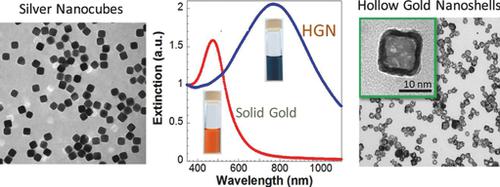当前位置:
X-MOL 学术
›
Adv. Funct. Mater.
›
论文详情
Our official English website, www.x-mol.net, welcomes your
feedback! (Note: you will need to create a separate account there.)
Optimizing the NIR Fluence Threshold for Nanobubble Generation by Controlled Synthesis of 10–40 nm Hollow Gold Nanoshells
Advanced Functional Materials ( IF 18.5 ) Pub Date : 2018-01-11 , DOI: 10.1002/adfm.201705272 Maria O Ogunyankin 1 , Jeong Eun Shin 1 , Dmitri O Lapotko 1 , Vivian E Ferry 1 , Joseph A Zasadzinski 1
Advanced Functional Materials ( IF 18.5 ) Pub Date : 2018-01-11 , DOI: 10.1002/adfm.201705272 Maria O Ogunyankin 1 , Jeong Eun Shin 1 , Dmitri O Lapotko 1 , Vivian E Ferry 1 , Joseph A Zasadzinski 1
Affiliation

|
The laser fluence to trigger nanobubbles around hollow gold nanoshells (HGN) with near infrared light is examined through systematic modification of HGN size, localized surface plasmon resonance (LSPR), HGN concentration, and surface coverage. Improved temperature control during silver template synthesis provides monodisperse, silver templates as small as 9 nm. 10 nm HGN with <2 nm shell thickness are prepared from these templates with a range of surface plasmon resonances from 600 to 900 nm. The fluence of picosecond near infrared (NIR) pulses to induce transient vapor nanobubbles decreases with HGN size at a fixed LSPR wavelength, unlike solid gold nanoparticles of similar dimensions that require an increased fluence with decreasing size. Nanobubble generation causes the HGN to melt with a blue shift of the LSPR. The nanobubble threshold fluence increases as the irradiation wavelength moves off the nanoshell LSPR. Surface treatment does not influence the threshold fluence. The threshold fluence increases with decreasing HGN concentration, suggesting that light localization through multiple scattering plays a role. The nanobubble threshold to rupture liposomes is four times smaller for 10 nm than for 40 nm HGN at a given LSPR, allowing us to use HGN size, LSPR, laser wavelength and fluence to control nanobubble generation.
中文翻译:

通过 10-40 nm 空心金纳米壳的受控合成优化纳米气泡生成的近红外通量阈值
通过系统修改 HGN 尺寸、局域表面等离子体共振 (LSPR)、HGN 浓度和表面覆盖率,检查用近红外光触发空心金纳米壳 (HGN) 周围纳米气泡的激光注量。银模板合成过程中改进的温度控制提供了小至 9 nm 的单分散银模板。由这些模板制备具有 <2 nm 壳厚度的 10 nm HGN,其表面等离子体共振范围为 600 至 900 nm。在固定的 LSPR 波长下,皮秒近红外 (NIR) 脉冲诱导瞬态蒸气纳米气泡的注量随着 HGN 尺寸的减小而减小,这与类似尺寸的固体金纳米颗粒不同,后者需要随着尺寸的减小而增加注量。纳米气泡的产生导致 HGN 融化,局域表面等离子体共振发生蓝移。随着照射波长离开纳米壳局域表面等离子体共振,纳米气泡阈值注量增加。表面处理不影响阈值通量。阈值注量随着 HGN 浓度的降低而增加,表明通过多重散射的光定位发挥了作用。在给定的 LSPR 下,10 nm HGN 的纳米气泡破裂脂质体阈值比 40 nm HGN 小四倍,这使我们能够使用 HGN 尺寸、LSPR、激光波长和注量来控制纳米气泡的生成。
更新日期:2018-01-11
中文翻译:

通过 10-40 nm 空心金纳米壳的受控合成优化纳米气泡生成的近红外通量阈值
通过系统修改 HGN 尺寸、局域表面等离子体共振 (LSPR)、HGN 浓度和表面覆盖率,检查用近红外光触发空心金纳米壳 (HGN) 周围纳米气泡的激光注量。银模板合成过程中改进的温度控制提供了小至 9 nm 的单分散银模板。由这些模板制备具有 <2 nm 壳厚度的 10 nm HGN,其表面等离子体共振范围为 600 至 900 nm。在固定的 LSPR 波长下,皮秒近红外 (NIR) 脉冲诱导瞬态蒸气纳米气泡的注量随着 HGN 尺寸的减小而减小,这与类似尺寸的固体金纳米颗粒不同,后者需要随着尺寸的减小而增加注量。纳米气泡的产生导致 HGN 融化,局域表面等离子体共振发生蓝移。随着照射波长离开纳米壳局域表面等离子体共振,纳米气泡阈值注量增加。表面处理不影响阈值通量。阈值注量随着 HGN 浓度的降低而增加,表明通过多重散射的光定位发挥了作用。在给定的 LSPR 下,10 nm HGN 的纳米气泡破裂脂质体阈值比 40 nm HGN 小四倍,这使我们能够使用 HGN 尺寸、LSPR、激光波长和注量来控制纳米气泡的生成。











































 京公网安备 11010802027423号
京公网安备 11010802027423号